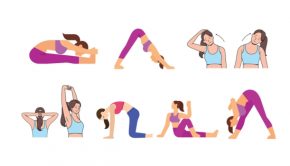CrossFit Workouts
Expect Whole-Body Functional Fitness
While most traditional exercise plans target a specific area of fitness—like jogging for cardiovascular health or weightlifting for strength—CrossFit focuses on all of them by combining many types of exercise. A typical mixture might include weightlifting, gymnastics, aerobics and explosive plyometrics, energetic and fast-acting movements that improve strength and speed. The goal is to enable the body to respond to many different and sometimes competing stimuli. “CrossFit training prepares the body not only for the unknown, but for the unknowable, as well,” explains Greg Glassman, founder of CrossFit.
Due to its nonspecific nature, this approach may not be best for an athlete focusing exclusively on one sport. “While it may not help you become an elite marathoner, this can be an effective training regimen for those interested in broad-based, functional fitness,” advises Bob LeFavi, Ph.D., a certified strength and conditioning specialist, senior coach for USA Weightlifting and professor of sports medicine at Armstrong Atlantic State University, in Savannah, Georgia.
The program requires disciplined workouts three to five days a week in an intense circuit format with little rest. This allows the practitioner to finish in five to 30 minutes, depending upon his or her current fitness level and the day’s plan.
Nuts and Bolts
A free Workout of the Day (WOD) is posted daily on CrossFit.com. WODs generally involve exercises using combinations of Olympic weights, dumbbells, kettlebells, medicine balls, gymnastic rings, climbing ropes, jump ropes and rowing machines. Bodyweight-only exercises such as push-ups, sit-ups and pull-ups are commonly included.
Most WODs are named for women or fallen military heroes. Here are a few examples.
Cindy – as many rounds as possible of five pull-ups, 10 push-ups and 15 bodyweight squats within 20 minutes
Angie – 100 pull-ups, 100 push-ups, 100 sit-ups and 100 bodyweight-only squats with in-between breaks
Murph – a one-mile run, followed by 100 pull-ups, 200 push-ups, 300 bodyweight squats and another one-mile run; advanced athletes do it all wearing a 20-pound vest
The objective is to beat one’s own overall best time with each workout.
“CrossFit training is unique in that it rarely schedules rest periods, unless specified as part of the WOD,” says Brian Kliszczewicz, a CrossFit researcher and Ph.D. student of exercise physiology at Auburn University, in Alabama. “Your fitness level will determine the length, intensity and duration of each WOD.” Kliszczewicz’ recent research found that CrossFit subjects expended more than 250 calories on average during 20 minutes of the Cindy workout.
Any WOD can be done at home with the proper equipment, a base level of physical fitness and knowing how to properly execute each exercise. Consulting with a coach can help; be sure to ask for credentials and references, including education and experience in sports science and conditioning.
Glassman also suggests visiting one of 5,000 CrossFit affiliates worldwide; warehouse-like facilities that are unlike traditional fitness centers in that they don’t have lots of machines. Instead, the only equipment available is what’s necessary for conducting WODs. Workouts are completed in groups, with participants usually performing the same exercises, directed by a CrossFit coach trained to observe individual technique.
Because athletes like to compete with themselves and others, they can post their personal bests for each WOD on the CrossFit website.
Injury Risk
Professor Henry N. Williford, EdD, a fellow of the American College of Sports Medicine and department head of Physical Education and Exercise Science at Auburn University at Montgomery, cautions, “Make sure the staff at a CrossFit affiliate is appropriately trained to deal with emergencies; at a minimum, they should be certified in cardiopulmonary resuscitation (CPR) and first aid.” Let the coach know of any discomfort or pain during a workout.
As an intense workout progresses, many CrossFit exercises can be performed as one is becoming increasingly tired, increasing the risk of injury to a joint or muscle. Beginners, seniors and anyone out of shape or with a previous injury or health condition needs to take additional precautions; basic guidelines for physical activity are published by the American College of Sports Medicine at Tinyurl.com/BasicExerciseGuidelines.
It’s important to start slow and gradually increase the intensity of workouts. “Personal safety is always a major factor that must to be considered when selecting any exercise regimen,” remarks Williford.
Requirements for starting to practice CrossFit exercises include a base level of sufficient physical strength to handle the demands, which may be achieved by first following a less intense plan. Always check with a physician before starting any exercise program.
Michael R. Esco, Ph.D., is an associate professor of exercise science versed in sports medicine and director of the Human Performance Laboratory at Auburn University at Montgomery, AL.





























